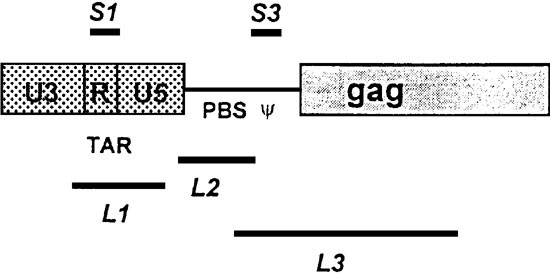
- Select a language for the TTS:
- UK English Female
- UK English Male
- US English Female
- US English Male
- Australian Female
- Australian Male
- Language selected: (auto detect) - EN
Play all audios:
ABSTRACT Antisense RNA has proven a potent inhibitor of gene expression and has the potential to inhibit retroviral replication at a number of stages in the virus life cycle by targeting
both viral and cellular RNA sequences. Antisense RNA complementary to three target regions in the 5′ leader/LTR of human immunodeficiency virus type-1 (HIV-1), the TAR region, the primer
binding site and the splice donor (SD)-packaging signal (ψ) region were stably expressed from the CMV IE promoter in Jurkat cells, and expression confirmed by RT-PCR. When challenged with
HIV-1, cell lines expressing antisense RNA targeting the SD/ψ region showed significant inhibition of replication (at up to 106 TCID 50/ml). These sequences were also expressed in
lymphocytes after transduction using recombinant retroviruses and one sequence complementary to the SD/ψ region inhibited replication of HIV-1. A co-transfection assay using COS-1 cells was
also developed both to confirm the antiviral potential of these sequences, and to determine the predominant site of action of these molecules. Antisense RNAs targeting the ψ region and one
sequence complementary to the TAR region inhibited expression of viral protein; furthermore, analyses of relative levels of cellular and virion RNA from these assays suggest each of these
antisense molecules exerts its effect at an early stage in the transcription–translation pathway, while the longer of the sequences also inhibited packaging of virion RNA. These results
suggest that the packaging signal (ψ) of HIV-1 represents an attractive target for antisense RNA-based gene therapy, although the main mode of action of such molecules may well be through
antisense effects at an earlier stage of replication than packaging. Access through your institution Buy or subscribe This is a preview of subscription content, access via your institution
ACCESS OPTIONS Access through your institution Subscribe to this journal Receive 6 print issues and online access $259.00 per year only $43.17 per issue Learn more Buy this article *
Purchase on SpringerLink * Instant access to full article PDF Buy now Prices may be subject to local taxes which are calculated during checkout ADDITIONAL ACCESS OPTIONS: * Log in * Learn
about institutional subscriptions * Read our FAQs * Contact customer support SIMILAR CONTENT BEING VIEWED BY OTHERS EVIDENCE THAT TWO INSTEAD OF ONE DEFECTIVE INTERFERING RNA IN INFLUENZA A
VIRUS-DERIVED DEFECTIVE INTERFERING PARTICLES (DIPS) DOES NOT ENHANCE ANTIVIRAL ACTIVITY Article Open access 14 October 2021 CHEMOGENETIC ON AND OFF SWITCHES FOR RNA VIRUS REPLICATION
Article Open access 01 March 2021 1MΨ INFLUENCES THE PERFORMANCE OF VARIOUS POSITIVE-STRANDED RNA VIRUS-BASED REPLICONS Article Open access 31 July 2024 REFERENCES * Lever AML . Gene therapy
for HIV infection. In: Goodfellow P, Lever AML (eds) _British Medical Bulletin_ VOL. 51: 1995 pp 149–166 Article Google Scholar * Morgan RA . Gene therapy for HIV infection _Clin Exp
Immunol_ 1997 1: 41–44 Google Scholar * Berkhout B . Structure and function of the human immunodeficiency virus leader RNA _Prog Nucl Acid Res Mol Biol_ 1996 54: 1–34 Article CAS Google
Scholar * Harrison GP _et al_. Functional analysis of the core packaging signal in a permissive cell line _J Virol_ 1998 72: 5886–5896 CAS PubMed PubMed Central Google Scholar * McBride
MS, Panganiban AT . The human immunodeficiency virus type 1 encapsidation site is a multipartite RNA element composed of functional hairpin structures _J Virol_ 1996 70: 2963–2973 CAS
PubMed PubMed Central Google Scholar * Wei P _et al_. A novel CDK9-associated C-type cyclin interacts directly with HIV-1 Tat and mediates its high-affinity, loop-specific binding to TAR
RNA _Cell_ 1998 92: 451–462 Article CAS PubMed Google Scholar * Das AT, Klaver B, Berkhout B . Reduced replication of human immunodeficiency virus type 1 mutants that use reverse
transcription primers other than the natural tRNA(3Lys) _J Virol_ 1995 69: 3090–3097 CAS PubMed PubMed Central Google Scholar * Kaye JF, Lever AML . Trans-acting proteins involved in RNA
encapsidation and viral assembly in human immunodeficiency virus type 1 _J Virol_ 1996 70: 880–886 CAS PubMed PubMed Central Google Scholar * Khan R, Giedroc DP . Recombinant human
immunodeficiency virus type 1 nucleocapsid (NCp7) protein unwinds tRNA _J Biol Chem_ 1992 267: 6689–6695 CAS PubMed Google Scholar * Chatterjee S, Johnson PR, Wong KK Jr . Dual-target
inhibition of HIV-1 _in vitro_ by means of an adeno-associated virus antisense vector _Science_ 1992 258: 1485–1488 Article CAS PubMed Google Scholar * Joshi S _et al_. Inhibition of
human immunodeficiency virus type 1 multiplication by antisense and sense RNA expression _J Virol_ 1991 65: 5524–5530 CAS PubMed PubMed Central Google Scholar * Sczakiel G, Pawlita M .
Inhibition of human immunodeficiency virus type 1 replication in human T cells stably expressing antisense RNA _J Virol_ 1991 65: 468–472 CAS PubMed PubMed Central Google Scholar * Sun
LQ _et al_. Resistance to human immunodeficiency virus type 1 infection conferred by transduction of human peripheral blood lymphocytes with ribozyme, antisense, or polymeric
trans-activation response element constructs _Proc Natl Acad Sci USA_ 1995 92: 7272–7276 Article CAS PubMed PubMed Central Google Scholar * Veres G _et al_. Comparative analyses of
intracellularly expressed antisense RNAs as inhibitors of human immunodeficiency virus type 1 replication _J Virol_ 1998 72: 1894–1901 CAS PubMed PubMed Central Google Scholar *
Morgenstern JP, Land H . Advanced mammalian gene transfer: high titre retroviral vectors with multiple drug selection markers and a complementary helper-free packaging cell line _Nucleic
Acids Res_ 1990 18: 3587–3596 Article CAS PubMed PubMed Central Google Scholar * Cosset FL _et al_. High-titer packaging cells producing recombinant retroviruses resistant to human
serum _J Virol_ 1995 69: 7430–7436 CAS PubMed PubMed Central Google Scholar * Veres G _et al_. Intracellular expression of RNA transcripts complementary to the human immunodeficiency
virus type-1 gag gene inhibits viral replication in human CD4(+) lymphocytes _J Virol_ 1996 70: 8792–8800 CAS PubMed PubMed Central Google Scholar * Peng H _et al_. Long-term protection
against HIV-1 infection conferred by tat or rev antisense RNA was affected by the design of the retroviral vector _Virology_ 1996 220: 377–389 Article CAS PubMed Google Scholar *
Vandendriessche T _et al_. Inhibition of clinical human immunodeficiency virus (HIV) type 1 isolates in primary CD4+ T lymphocytes by retroviral vectors expressing anti-HIV genes _J Virol_
1995 69: 4045–4052 CAS PubMed PubMed Central Google Scholar * Donahue RE _et al_. Reduction in SIV replication in rhesus macaques infused with autologous lymphocytes engineered with
antiviral genes _Nature Med_ 1998 4: 181–186 Article CAS PubMed Google Scholar * Walker RE . A phase I/II pilot study of the safety of the adoptive transfer of syngeneic gene-modified
cytotoxic T lymphocytes in HIV-infected identical twins _Hum Gene Ther_ 1996 7: 367–400 Article CAS PubMed Google Scholar * Riddell SR _et al_. T-cell mediated rejection of gene-modified
HIV-specific cytotoxic T lymphocytes in HIV-infected patients _Nature Med_ 1996 2: 216–223 Article CAS PubMed Google Scholar * Weintraub HM . Antisense RNA and DNA. Molecules that bind
with specific messenger RNA's can selectively turn off genes. Eventually certain diseases may be treated with them; today antisense molecules are valuable research tools _Sci Am_ 1990
262: 34–40 Article Google Scholar * Zeffman A _et al_. The major HIV-1 packaging signal is an extended bulged stem loop whose structure is altered on interaction with the Gag polyprotein
_J Mol Biol_ 2000 297: 877–893 Article CAS PubMed Google Scholar * Ausubel FM _et al_. _Current Protocols in Molecular Biology_ Wiley-Interscience: New York 1991 Google Scholar *
Steffens DL, Gross RW . Sequencing of cloned DNA using bacteriophage lambda gt11 templates _Biotechniques_ 1989 7: 674–680 CAS PubMed Google Scholar * Richardson JH _et al_. Helper
virus-free transfer of human immunodeficiency virus type 1 vectors _J Gen Virol_ 76: 691–696 Article CAS PubMed Google Scholar Download references ACKNOWLEDGEMENTS This work was
supported by a MRC Clinical Training Fellowship (DC): G84/4391 and the Sykes Trust. AUTHOR INFORMATION AUTHORS AND AFFILIATIONS * Department of Medicine, University of Cambridge,
Addenbrooke's Hospital, Cambridge, CB2 2QQ, UK D R Chadwick & A M L Lever Authors * D R Chadwick View author publications You can also search for this author inPubMed Google Scholar
* A M L Lever View author publications You can also search for this author inPubMed Google Scholar RIGHTS AND PERMISSIONS Reprints and permissions ABOUT THIS ARTICLE CITE THIS ARTICLE
Chadwick, D., Lever, A. Antisense RNA sequences targeting the 5′ leader packaging signal region of human immunodeficiency virus type-1 inhibits viral replication at post-transcriptional
stages of the life cycle. _Gene Ther_ 7, 1362–1368 (2000). https://doi.org/10.1038/sj.gt.3301254 Download citation * Received: 28 February 2000 * Accepted: 03 May 2000 * Published: 21 August
2000 * Issue Date: 01 August 2000 * DOI: https://doi.org/10.1038/sj.gt.3301254 SHARE THIS ARTICLE Anyone you share the following link with will be able to read this content: Get shareable
link Sorry, a shareable link is not currently available for this article. Copy to clipboard Provided by the Springer Nature SharedIt content-sharing initiative KEYWORDS * HIV * antisense RNA
* post-transcriptional




:max_bytes(150000):strip_icc():focal(216x0:218x2)/amber-marchese-435-b88b7176e5cf4ac1be7729143214493c.jpg)


:max_bytes(150000):strip_icc():focal(749x0:751x2)/charles-meghan-3-62cd67a817ea469ca1c5482244a8245c.jpg)